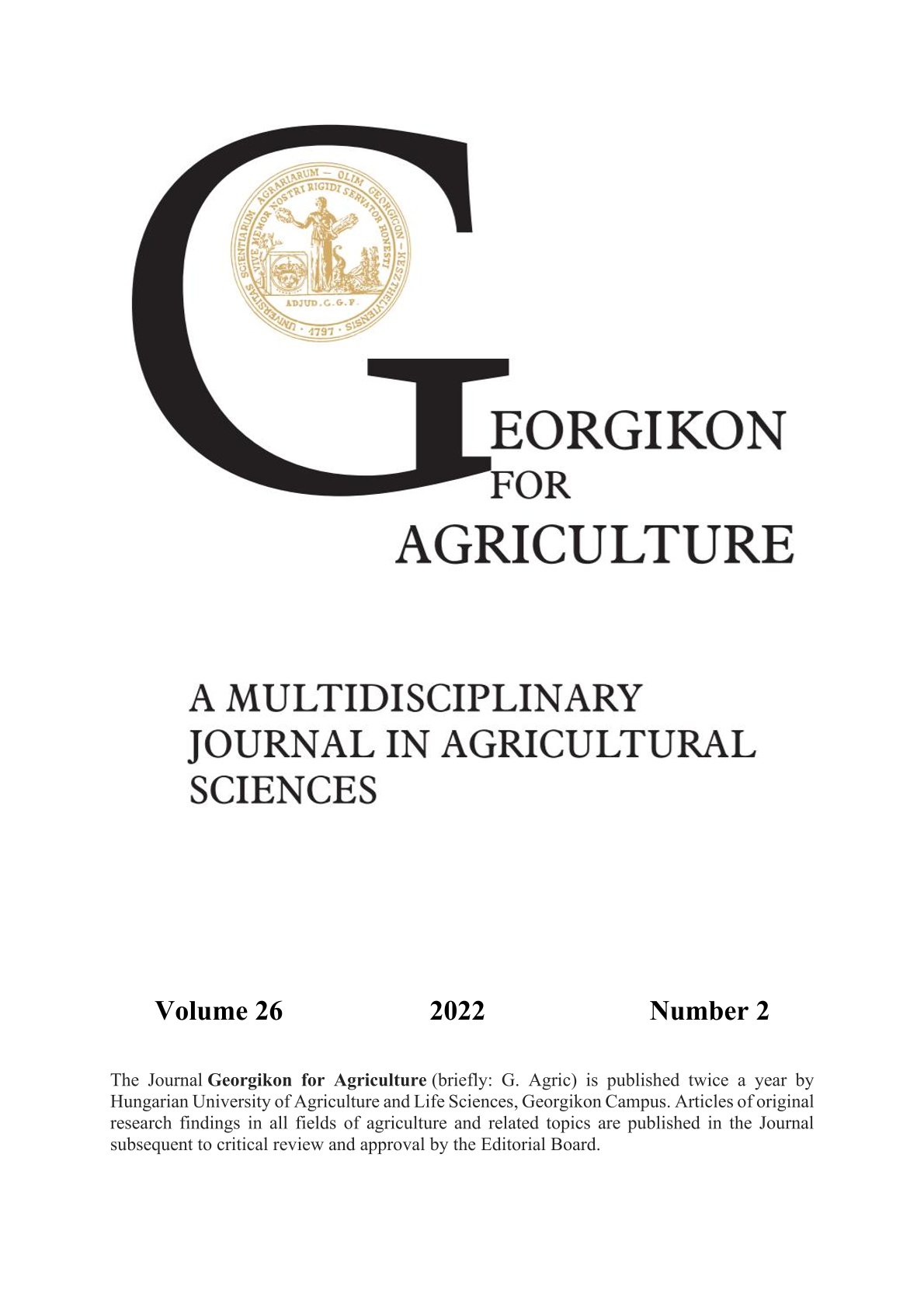Detection of viral infections in a hungarian vineyard
Keywords:
DAS-ELISA, grapevine, virus, plant protectionAbstract
Grape (Vitis vinifera) belonging to the family of Vitaceae, is one of the most important economic fruit crops in the world. For thousands of years in Hungry, grapevine has been cultivated in the Carpathian basin, where climatic and soil conditions are suitable for grape vine production. However, it is facing adversity of virus infections that influenced negatively the performance of the cultivars at an extent, which cause premature death of the stocks and generating great yield losses. The study was conducted in a Grapevine plantation from the area of Central Transdanubia (Lesencefalu) to diagnose important viral diseases that infect Othello variety and suggest measures possible for enhancing disease control and management strategies. Othello is also a commonly cultivated variety in Hungary with the assumption of possible tolerance to important grapevine diseases. 60 samples were collected from Othello grapevine variety and analysed in the laboratory to investigate virus infection using DASELISA. Six viruses (GLRaV1, GLRaV2, GLRaV3, GLRaV6, GLRaV7 and GFkV) were found to infect this variety. Among those 60 samples, 27 samples were infected with viruses, almost half of the investigated leaf samples. The highest infection was found to be caused by GLRaV1 whilst the lowest infection was found to be associated with GLRaV3. However, 13 samples were found to be infected with more than one virus (multiple infection) whilst 14 samples were found to be infected with only one virus (single infection).
References
Adnan, M.R., Chen, Z., Yuan, X., Kisi, O., El-Shafie, A., Kuriqi, A. and Ikram, M. 2020. Reference Evapotranspiration Modeling Using New Heuristic Methods. Entropy. 22(5). 547. https://doi.org/10.3390/e22050547
Al Rwahnih, M., Daubert, S., Golino, D. and Rowhani, A. 2009. Deep sequencing analysis of RNAs from a grapevine showing Syrah decline symptoms reveals a multiple virus infection that includes a novel virus. Virology. 387. 395–401. https://doi.org/10.1016/j.virol.2009.02.028
Alabi, O.J., Casassa, L.F., Gutha, L.R., Larsen, R.C., Henick-Kling, T., Harbertson, J.F. and Naidu, R.A. 2016. Impacts of grapevine leafroll disease on fruit yield and grape and wine chemistry in a wine grape (Vitis vinifera L.) cultivar. PLoS ONE. 11. e0149666. https://doi.org/10.1371/journal.pone.0149666
Buyukbay, E., Uzunoz, M. and Sibel, G. 2011. Post-harvest losses in tomato and fresh bean production in Turkey. Scientific Research and Essays. 6(7). 1656–1666. https://doi.org/10.5897/SRE11.186
Clark, M.F., Adams, A.N. and Barbara, D.J. (1976). The Detection of Plant viruses by Enzyme-Linked Immunosorbent Assay (ELISA). Acta Hortic. 67, 43–50. https://doi.org/10.17660/ActaHortic.1976.67.2
Credi, R. 2001. Malattie infettive latenti e semilatenti della vite [Latent and semi latent infectious diseases of grapevine]. Quaderno di Viticoltura ed Enologia, Università di Torino 25. 15–25. https://om.ciheam.org/om/pdf/b55/00800521.pdf
FAO, 2012. Major Fruits and Vegetables producing Countries in the World (2010-2011). Rome, Italy.
Frison, E. A. and Ikin, R. (eds.). 1991. FAO/IBPGR Technical Guidelines for the Safe Movement of Grapevine Germplasm. Food and Agriculture Organization of the United Nations, Rome/International Board for Plant Genetic Resources, Rome.
Habili, N., Komínek, P. and Little, A. 2007. Grapevine leafroll-associated virus 1 as a common grapevine pathogen. Plant Viruses 1. 63–68.
Hajdu, E. 2018. Viticulture of Hungary. cta Agraria Debreceniensis. 150. 175–182. https://doi.org/10.34101/actaagrar/150/1713
Kritzman, A., Lampel, M., Raccah, B. and Gera, A. 2001. Distribution and Transmission of Iris yellow spot virus. Plant Disease. 85. 838–842. https://doi.org/10.1094/PDIS.2001.85.8.838.
Kumar, R. T. 2010. Post-harvest profile of grapes. Ministry of Agriculture, Department of Agriculture and Cooperation, Directorate of Marketing and Inspection, MPDC, Nagpur, India. pp 72.
Lázár, J. 2003. Sanitary aspects and results of the Hungarian grape breeding. Proceedings of the VIIIth International Conference on Grape Genetics and Breeding, ISHS Acta Horticulturae 603. 755–762. https://doi.org/10.17660/ActaHortic.2003.603.107
Maliogka, V.I., Martelli, G.P., Fuchs, M. and Katis, N.I. 2015. Control of viruses infecting grapevine. Advances in Virus Research. 91. 176–227. https://doi.org/10.1016/bs.aivir.2014.11.002
Mannini, F. and Digiaro, M. 2017. In Grapevine Viruses: Molecular Biology, Diagnostics and Management Springer: AG, Chapter 23. 453–482.
Martelli, G. P. 2014. Directory of virus and virus-like diseases of the grapevine and their agents. Journal of Plant Pathology. 96(1). 1–136. http://dx.doi.org/10.4454/JPP.V96I1SUP
Meng, B., Martelli, G.P., Golino, D.A. and Fuchs, M. 2017. Grapevine Viruses: Molecular Biology, Diagnostics and Management. Springer: Heidelberg, Germany, 31–46.
Naidu, R., Rowhani, A., Fuchs, M., Golino, D. and Martelli, G. P. 2014. Grapevine leafroll: A complex viral disease affecting a high-value fruit crop. Plant Disease. 98(9). 1172–1185. http://dx.doi.org/10.1094/ PDIS-08-13-0880-FE
OEPP/EPPO, 2008. Certification scheme: Pathogen-tested material of grapevine varieties and rootstocks. PM 4/8(2), Bulletin OEPP/EPPO Bulletin. 38. 422–429.
OIV, 2016. Global economic viticulture report. Organization Internationale, Paris.
Rowhani, A., Uyemoto, J. K., Golino, A. D. and Martelli, G. P. 2005. Pathogen testing and certification of Vitis and Prunus species. Annual Review of Phytopathology. 43: 261–278. https://doi.org/10.1146/annurev.phyto.43.040204.135919
Seguin, J., Rajeswaran, R., Malpica-Lopez, N., Martin, R.R., Kasschau, K., Dolja, V.V., Otten, P., Farinelli, L. and Poogin, M.M. 2014. De novo reconstruction of consensus master genomes of plant RNA and DNA viruses from siRNAs. PloS One. 9. e88513. https://doi.org/10.1371/journal.pone.0088513
Senthil, R., Prabakar, K., Rajendran, L. and Karthikeyan, G. 2011. Efficacy of different biological control agents against major postharvest pathogens of grapes under room temperature storage conditions. Phytopathology Mediterranea. 50. 55−65. https://doi.org/10.14601/Phytopathol_Mediterr-3115
Smithsonian. 2013. Grapes and Viticulture in Hungary: Hungarian Heritage Roots to Revival. Folklife Festival- Washngton D.C., June26-June 30 and July 3−July 7.
Walker, A. R., Lee, E., Bogs, J., McDavid, D. A. J., Thomas, M. R. and Robinson, S. P. 2007. White grapes arose through the mutation of two similar and adjacent regulatory genes. Plant J. 49. 767−959. https://doi.org/10.1111/j.1365-313X.2006.02997.x
Downloads
Published
Issue
Section
License
Copyright (c) 2022 Agyemang Evans Duah, Nsongoma Martine Lihwa, Pásztor György, Takács András

This work is licensed under a Creative Commons Attribution-NonCommercial-NoDerivatives 4.0 International License.
Cikkre a Creative Commons 4.0 standard licenc alábbi típusa vonatkozik: CC-BY-NC-ND-4.0. Ennek értelmében a mű szabadon másolható, terjeszthető, bemutatható és előadható, azonban nem használható fel kereskedelmi célokra (NC), továbbá nem módosítható és nem készíthető belőle átdolgozás, származékos mű (ND). A licenc alapján a szerző vagy a jogosult által meghatározott módon fel kell tüntetni a szerző nevét és a szerzői mű címét (BY).




